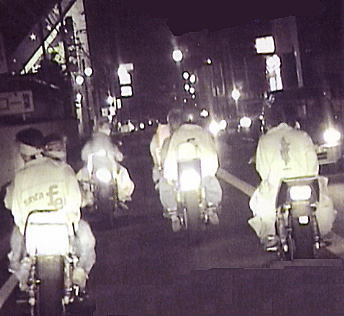Japanese Subculture
日本のサブカルチャー

Recently, we've been discussing a lot about culture, fashion and what is right or wrong in terms of art. Today, I read an article discussing Japanese subculture. It explained how their style and trend has developed over the years and the reasons behind it. The article was called 'Street Style and It's Meaning In Postwar Japan'.
Youth Tribes (Zoku)
According to the article, Zoku is a word used to describe subculture in Japan. Because there is no clear definition or concept of the word 'Subculture', Japan has come to associate it with youth, music and media. Zoku is more or less a group of young people keeping up with the latest trends and fashion. As time progressed, new words were invented in order to label a new group of adolescents following a certain trend. For example, in the late 1950s a new group of Zoku emerged and these were motorbike gangs; the Kaminari-Zoku. This means the Thunder Tribe because of the loud noises coming from their motorbikes on the streets.They were thought to be groups of teenagers trying to imitate the British 'Rockers & Greasers'.
 It's unknown whether or not they have the same view of teenage fashion as we do in Europe and America. From what I've read in the article, Zoku have been associated with crime and deviancy in the same way Britain portrays teenage culture. So, I'm unsure as to whether or not Japan recognise youth fashion as culture or just rebellion.I found this part of the article very interesting because it was something I knew I could relate as a young adult in today's modern world. Society fails to understand youth culture so instead they conjure up assumptions and conclusions instead of asking questions and attempting to understand.
It's unknown whether or not they have the same view of teenage fashion as we do in Europe and America. From what I've read in the article, Zoku have been associated with crime and deviancy in the same way Britain portrays teenage culture. So, I'm unsure as to whether or not Japan recognise youth fashion as culture or just rebellion.I found this part of the article very interesting because it was something I knew I could relate as a young adult in today's modern world. Society fails to understand youth culture so instead they conjure up assumptions and conclusions instead of asking questions and attempting to understand. I personally believe that media played a significant role when it came to the description of subculture in Japan.
Bosozoku (Anti Middle Class Style Of The Late 1970s)
I found this area of the article to be the most interesting due to the fact that it discusses teenage behaviour in relation to culture and fashion trends. It compares the way in which media portrays teenage culture in Japan and the way teenagers literally behave in their modern culture.
To illustrate Japanese adolescent behaviour, the article used a popular group in the 1970s known as the Bosozoku. These were a group of teenagers who were said to have descended from the earlier 1950s biker group known as the Kaminari Zoku which I mentioned earlier. The difference between the Bosozoku and the Kaminari Zoku is that the younger generation were more rebellious and less interested with fitting into society. These teenagers were a distinct group. They were easily spotted and identified due to their unique clothing. For example, they wore clothes that were given nicknames associated with frightening wear. These were clothes such as ToKkoFuku which meant 'The style of suicidal Kamikaze Party.' I'm assuming that the Bosozoku gang's intentions were to come across as frightening and intimidating. In comparison to today's modern cultural groups, there are still groups which try to protray themselves as intimidation and dangerous for a number of reason.
The Japanese Bosozoku were known to be high school drop outs who originally started off in normal gangs. These were to the teenagers who were normally associated with the more violent bike gangs. According the Globalist.Com, "Bosozoku bike members are much more carefree than violent. They are full of life, teenagers dedicated to the sublime intensity of youth. They are not the violent criminals that are portrayed in the Japanese media....". I liked this quote because, as I mentioned earlier, teenagers are portrayed as rebellious and troublesome according to the media. Therefore, despite the fact that this article is meant to come across as factual and evident, I believe that without actually going out there and getting involved in youth culture, one will always lack understanding about it.
Overall, these were the two areas of that I found the most interesting. This was mainly because groups within teenage culture fascinate me and it's something I can relate to.

No comments:
Post a Comment